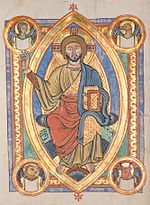
| Part of a series on |
| Devotions to Jesus in the Catholic Church |
|---|
 |
| Devotions |
| Prayers |
|
|
The Stations of the Cross or the Way of the Cross, also known as the Way of Sorrows or the Via Crucis, are a series of images depicting Jesus Christ on the day of his crucifixion and accompanying prayers. The stations grew out of imitations of the Via Dolorosa in Jerusalem, which is a traditional processional route symbolising the path Jesus walked to Mount Calvary. The objective of the stations is to help the Christian faithful to make a spiritual pilgrimage through contemplation of the Passion of Christ. It has become one of the most popular devotions and the stations can be found in many Western Christian churches, including those in the Roman Catholic,[1] Lutheran,[2][3] Anglican,[4] and Methodist traditions.[5][6]
Commonly, a series of 14 images will be arranged in numbered order along a path, along which worshippers—individually or in a procession—move in order, stopping at each station to say prayers and engage in reflections associated with that station. These devotions are most common during Lent, especially on Good Friday, and reflect a spirit of reparation for the sufferings and insults that Jesus endured during his passion.[7][8][9] As a physical devotion involving standing, kneeling and genuflections, the Stations of the Cross are tied with the Christian themes of repentance and mortification of the flesh.[1][10]
The style, form, and placement of the stations vary widely. The typical stations are small plaques with reliefs or paintings placed around a church nave. Modern minimalist stations can be simple crosses with a numeral in the centre.[7][11] Occasionally, the faithful might say the stations of the cross without there being any image, such as when the pope leads the stations of the cross around the Colosseum in Rome on Good Friday.[12]
- ^ a b Byrne, William (16 October 2020). 5 Things with Father Bill: Hope, Humor, and Help for the Soul. Loyola Press. ISBN 978-0-8294-5327-0.
- ^ "Stations of the Cross". Holy Trinity Lutheran Church. Archived from the original on 20 October 2017. Retrieved 20 October 2017.
- ^ "Good Friday: Stations of the Cross Explained". Sinclair Broadcast Group, Inc. (KJZZ14). 15 April 2022.
It has become standard for Catholic churches in the United States to mark the Stations of the Cross on Good Friday. In addition to Catholics, some Protestant churches, especially those belonging to the Episcopal [i.e., Anglican] or Lutheran denominations, also commemorate the Stations of the Cross as of their Lenten activities.
- ^ "Lent" (PDF). Church of England. 236. Archived from the original (PDF) on 5 July 2017. Retrieved 20 October 2017.
- ^ "Stations of the Cross". Trinity UMC. 24 March 2013. Archived from the original on 17 April 2015. Retrieved 17 April 2015.
- ^ Quann, Lynn (4 April 2017). "Stations of the Cross". Epworth United Methodist Church. Archived from the original on 26 March 2023. Retrieved 16 April 2022.
- ^ a b "Stations of the Cross". St. Michael's Episcopal Church. 2012. Archived from the original on 17 February 2015. Retrieved 3 March 2015.
- ^ Ann Ball, 2003 Encyclopedia of Catholic Devotions and Practices ISBN 0-87973-910-X
- ^ The Catholic Prayer Book and Manual of Meditations (1883) by Patrick Francis Moran /The Way of the Cross. Browne and Nolan.
- ^ Ryder, Henry Ignatius Dudley (1920). Sermons and Notes of Sermons. Sands & Company. p. 58.
- ^ Chryssides, George D.; Wilkins, Margaret Z. (11 September 2014). Christians in the Twenty-First Century. Taylor & Francis. p. 51. ISBN 978-1-317-54557-6.
- ^ "Frommer's Events – Event Guide: Good Friday Procession in Rome (Palatine Hill, Italy)". Frommer's. Archived from the original on 7 January 2009. Retrieved 8 April 2008.